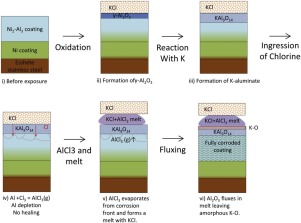当前位置:
X-MOL 学术
›
Corros. Sci.
›
论文详情
Our official English website, www.x-mol.net, welcomes your
feedback! (Note: you will need to create a separate account there.)
Breakdown mechanism of γ-Al2O3 on Ni2Al3 coatings exposed in a biomass fired power plant
Corrosion Science ( IF 7.4 ) Pub Date : 2020-07-01 , DOI: 10.1016/j.corsci.2020.108583 D.L. Wu , K.V. Dahl , F.B. Grumsen , T.L. Christiansen , M. Montgomery , J. Hald
Corrosion Science ( IF 7.4 ) Pub Date : 2020-07-01 , DOI: 10.1016/j.corsci.2020.108583 D.L. Wu , K.V. Dahl , F.B. Grumsen , T.L. Christiansen , M. Montgomery , J. Hald

|
Abstract A Ni2Al3 coated tube was exposed in a wood firing power plant for 7100 h. The exposure resulted in protective behaviour in most areas, while corrosion attack occurred in local areas. In areas exhibiting protective behaviour, a 30−50 nm thick γ-Al2O3 layer was found, and a 200−250 nm K–O rich amorphous layer was identified in the corroded area. A corrosion mechanism is suggested: γ-Al2O3 was broken down by reaction with KCl(g) resulting in formation of potassium aluminate. Migration of Cl through potassium aluminate resulted in formation of volatile AlCl3. KCl-AlCl3 then led to alumina fluxing and further corrosion attack.
中文翻译:

γ-Al2O3在生物质发电厂暴露的Ni2Al3涂层上的分解机制
摘要 Ni2Al3 涂层管在燃木发电厂中暴露了 7100 小时。暴露在大多数地区产生了保护行为,而在局部地区发生了腐蚀攻击。在表现出保护行为的区域,发现了 30-50 nm 厚的 γ-Al2O3 层,并在腐蚀区域发现了 200-250 nm 的富含 K-O 的非晶层。提出了一种腐蚀机制:γ-Al2O3 与 KCl(g) 反应分解,导致形成铝酸钾。Cl 通过铝酸钾的迁移导致形成挥发性的 AlCl3。KCl-AlCl3 然后导致氧化铝熔剂和进一步腐蚀侵蚀。
更新日期:2020-07-01
中文翻译:

γ-Al2O3在生物质发电厂暴露的Ni2Al3涂层上的分解机制
摘要 Ni2Al3 涂层管在燃木发电厂中暴露了 7100 小时。暴露在大多数地区产生了保护行为,而在局部地区发生了腐蚀攻击。在表现出保护行为的区域,发现了 30-50 nm 厚的 γ-Al2O3 层,并在腐蚀区域发现了 200-250 nm 的富含 K-O 的非晶层。提出了一种腐蚀机制:γ-Al2O3 与 KCl(g) 反应分解,导致形成铝酸钾。Cl 通过铝酸钾的迁移导致形成挥发性的 AlCl3。KCl-AlCl3 然后导致氧化铝熔剂和进一步腐蚀侵蚀。











































 京公网安备 11010802027423号
京公网安备 11010802027423号